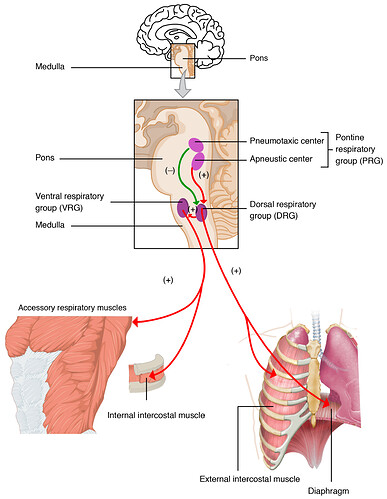-
The upper respiratory tract is composed of: the nose + pharynx + larynx
-
The lower respiratory tract goes from trachea to alveolus
-
The right lung is made up of 3 lobes and the left one 2 lobes
-
Muscles of expiration are internal intercostals + diaphragm + accessory muscles
-
Quiet breathing is a passive process
-
Why do we use spirometry? To diagnose an illness or to determine progress in a treatment
-
What volume can NOT be determined with spirometry ? residual volume
-
What volumes can be determined by spirometry ?

-
Gas exchange occurs in the alveoli
-
Surfactant fluid is synthesized by pneumocytes II
-
Surfactant fluid helps to reduce surface tension
-
Capacity of gas exchange is increased by the rich capillary network
-
Muscles of inspiration are external intercostals + diaphragm + accessory muscles
-
What is tidal volume? volume of air moved during quiet breathing
-
Lung volumes are influenced by height, location, and lifestyle
-
How does exercise affect ventilation?
- it increases the ventilation rate due to the greater frequency of breaths
- it increases the tidal volume due to the increase of the depth of breathing
-
What is VO2max? the maximum speed at which oxygen can be absorbed and delivered to body tissues
-
Explain the concepts of oxygen deficit and oxygen debt
-
What is the maximum volume inhaled called? inspiratory reserve volume
-
What is the maximum volume exhaled called? expiratory reserve volume
-
The pontine respiratory group is made of the pneumotaxic center and the apneustic center
-
How does the breathing center work?

-
What is the difference between ventilation and perfusion ?
- Ventilation is the air that reaches the alveoli
- Perfusion is the flow of blood into the alveoli
-
Ventilation helps to maintain a concentration gradient of oxygen
-
O2 levels are high in the alveoli and diffuse into the bloodstream
-
CO2 levels are low in the alveoli and diffuse from the bloodstream
-
Spirometry measures the amount and rate of air that a person breathes
-
How is CO2 transported?
- bound to Hb and therefore forms HbCO2
- dissolved in water
- diffuses in the red blood cell and converted into carbonic acid → 75% of it
-
Hb has a lower affinity with oxygen than HbO8
-
Explain the concept of cooperative binding
-
How is blood pH regulated?

-
Amino-acids are zwitterions which means that that they can either be positively or negatively charged
-
Lactic acid causes muscle ache, rapid breathing, and stomach pain
-
What is the difference between hemoglobin and myoglobin?
- Number of chains
- Number of oxygen bound
- Capacity to do cooperative binding
- Oxygen partial pressure diagram
-
The respiration center is located inside the medulla oblongata
-
Explain the Bohr effect
-
Hemoglobin can bind 4 oxygens
-
The affinity of hemoglobin with oxygen depends on how saturated it is (number of oxygen bound)
-
Central chemoreceptors are located in the medulla and peripheral chemoreceptors are located inside the carotid and aortic arch
-
The chemoreceptors are sensitive to PaCO2 and blood pH
-
The neurons in the respiratory center are called dorsal, ventral, and pontine respiratory group
-
Mb has a higher affinity for oxygen than adult Hb and consequently becomes saturated at lower oxygen levels
-
The Bohr shift explains the increased release of oxygen by Hb
-
Explain how we go from CO2 in the lungs to bicarbonate and vice versa

-
Partial pressure occurs when there is more than one gas in one structure
-
Total pressure is equal to the sum of all the partial pressures
-
Why do athletes train in high altitudes?
- production of red blood cells increases to make up for the lack of oxygen
- they have more Hb with a higher affinity for oxygen
- vital capacity is raised
- muscles produce more myoglobin
- kidneys produce alkaline urine to remove the excess bicarbonates: this acts as a buffer for the blood pH
-
Myoglobin is found in skeletal muscles tissues
-
Myoglobin can bind 1 oxygen